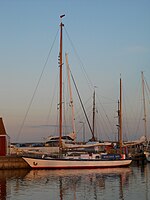Berlin Bear (ship)
|
Berlin Bear in Klintholm Havn, Denmark, 2011
|
||||||||||||||||||
|
||||||||||||||||||
|
||||||||||||||||||
|
||||||||||||||||||
|
||||||||||||||||||
The Berlin bear is a yawl .
It is the largest vehicle in the GDR , which was built on a private initiative in collective work 1963–65. Until 2020 it was owned by the Segel-Club-Flakensee eV association and not privately owned. The yacht was best known for a trip to the Mediterranean Sea from 1965–1966, and thus after the Wall was built in 1961. The participation and tolerance of the trip by state organs of the GDR ( Stasi ) and the SED is the subject of a television report. In 1967, films were also broadcast on youth television in the GDR .
The ship was sold in 2020. It is to be prepared for a circumnavigation in the next 5 years.
The vehicle
A postage stamp is said to have served as the inspiration for the yacht. The line plan for the yacht comes from Werner Siegel, who was actually a designer by profession. It is a scaled-down version of the yacht he designed, Always Ready! for the pioneer organization Ernst Thälmann of the GDR.
The hull consists of welded steel plates on frames and has a heaving keel. The bunks are divided into the engine compartment, galley, mess , lodging , and sailing load in the three central rooms. The rig is designed as Bermudayawl a 16.4 m high wholesale and a 9 meter high Besanmast .
After a construction period of three years, the ship was launched on May 29, 1965 at Flakensee on the premises of the company sports club Chemie Erkner . All materials and working hours were privately organized and carried. The particular general supply situation and availability of special materials must be taken into account. The construction already attracted a lot of attention in the GDR. Before leaving the country, the President of the People's Chamber, Prof. Dr. Dieckmann as a guest on board.
The trip in the Mediterranean
The departure began on September 19, 1965 in Stralsund . Only a few of the active builders were able to start the journey, as the state refused them to travel. Reliable comrades were used for this. Also in the replacement team in Split were only trustworthy people on board.
The report contained in Behrend's book was heavily censored; many passages give a positive image of the GDR. At the beginning of the trip, reports from the trip were also printed in the SED newspaper Neues Deutschland . But after the number of letters to the readers far exceeded the expected and the tenor was: Why them and not us? , the report ended without comment. The reports arriving from the yacht were only accepted. In the Zs. "Segelsport", however, reports from Harald Dorau were printed continuously until his return.
The route went from Stralsund across the English Channel , Biscay and Gibraltar directly into the Adriatic . But only Finisterre and Gibraltar were called. The next stop was Split in Yugoslavia . There the vehicle was taken to a shipyard and the crews were exchanged. From there it went to Alexandria via the stations Bari and Brindisi . Then Beirut , Famagusta and Heraklion were called. After the Strait of Messina one visited Stromboli , Naples and Pompeii . With the ports of Bastia and Marseille , the journey in the Mediterranean ended with the laying of the masts in Port-de-Bouc . A river trip on the Rhône towards home followed. Via the Saône , the Doubs , the Rhine-Rhône Canal and the Grand Canal d'Alsace it went to the Rhine; from there via the Rhine-Herne Canal , the Dortmund-Ems Canal to the Mittelland Canal ; It finally went to the Elbe via the Weser and Oste-Hamme Canal . The masts were set up again in Rendsburg and Stralsund was called again on May 13th.
After the Mediterranean voyage
After returning, the yacht was used for training trips in the coastal area of the GDR and for long trips to socialist countries. So until the end of the GDR, this affected the Baltic Sea region . Although she took part in various regattas, as a built cruising sailor with an amateur crew, she was not able to achieve great success. In 1988 and 1989, the hull was completely renewed so that no trips were made during these years. After 1989, the yacht is still managed by the Flakensee sailing club and continues to sail with changing crews on the Baltic Sea, but also around England and to the Lofoten Islands.
literature
- Karl Behrend: Cruise in the Mediterranean. VEB FA Brockhaus Verlag, Leipzig 1968. It contains a sail plan
- Siegfried Ressel: GDR sailing ship in the Mediterranean. Socialism on the move , in: Spiegel online, Reise (June 5, 2007) [3]
- Marius Schlösser: "Berliner Bär" - cruiser yacht , in Yachtsport Archive
- Report: Siegfried Ressel , Jens Arndt: To the horizon and back. Like a GDR yacht in the Mediterranean, MDR and RBB came in 2007, 45 min
- Dietlinde Stange: 60 years of the Woltersdorf sailing club 1955–2015. Chronicle Woltersdorf 2015
- Rita Kindler (Ed.) "Berliner Bär - The story of a legendary GDR ocean yacht", edition bodoni Buskow 2019 ISBN 978-3-947913-03-9
Web links
- The yacht on www.sc-flakensee.de
- The vehicle is visible on Google Earth under the coordinates given above .
Coordinates: 52 ° 26 ′ 38.1 ″ N , 13 ° 45 ′ 30.3 ″ E
Footnotes
- ↑ This vehicle drives today under the name Greif von Ueckermünde , cf. [1] .
- ^ On the first page of the New Germany newspaper of May 30, 1965 [2] ; Registration required, free registration possible
